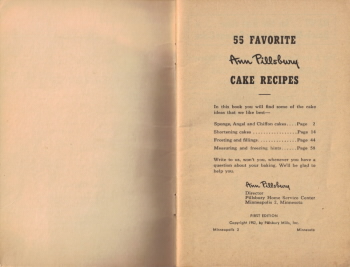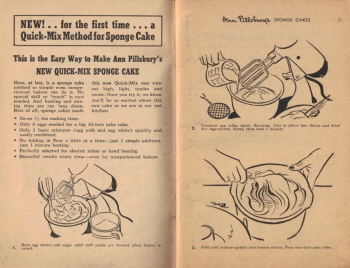 Here are pages 2 and 3 from the vintage cookbook “Kate Smith chooses her 55 Favorite Ann Pillsbury CAKE RECIPES”. This was published in 1952 by Pillsbury Mills, Inc. Kate Smith was a popular singer and radio personality with a career that began in the 1930s.
Here are pages 2 and 3 from the vintage cookbook “Kate Smith chooses her 55 Favorite Ann Pillsbury CAKE RECIPES”. This was published in 1952 by Pillsbury Mills, Inc. Kate Smith was a popular singer and radio personality with a career that began in the 1930s.
You can view all the pages in this cookbook by visiting this category: 55 Favorite Cake Recipes: Kate Smith, just click a page title to view that section. There is a scan of the pages included below as well as a scan of the inside cover and the first page which is the table of contents.
NEW! . . for the first time . . . a Quick-Mix Method for Sponge Cake
This is the Easy Way to Make Ann Pillsbury’s NEW QUICK-MIX SPONGE CAKE
Here, at last, is a sponge cake method so simple even inexperienced bakers can do it. No special skill or “touch” is now needed. And beating and mixing time are cut ‘way down. Best of all, sponge cakes made this new Quick-Mix way turn out high, light, tender and moist. Once you try it, we know you’ll be as excited about this new cake as we are in our test kitchen.
- Saves 1/3 the making time.
- Only 6 eggs needed for a big 10-inch tube cake.
- Only 2 basic mixtures (egg yolk and egg white) quickly and easily combined.
- No folding in flour a little at a time–just 1 simple addition, just 1 minute beating.
- Perfectly adapted for electric mixer or hand beating.
- Beautiful results every time–even by inexperienced bakers.
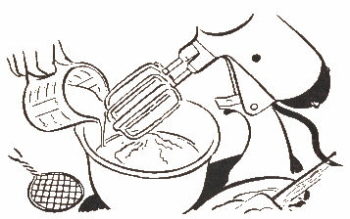
1. Beat egg whites and sugar until stiff peaks are formed when beater is raised.
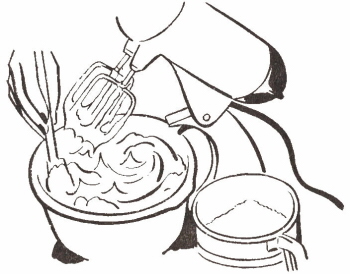
2. Combine egg yolks, water, flavoring. Add to sifted Sno Sheen and other dry ingredients; blend, then beat 1 minute.
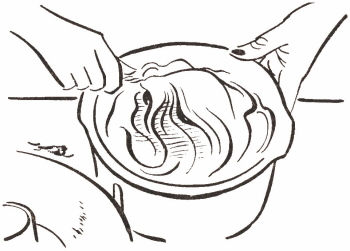
3. Fold yolk mixture gently into beaten whites. Pour into tube pan; bake.
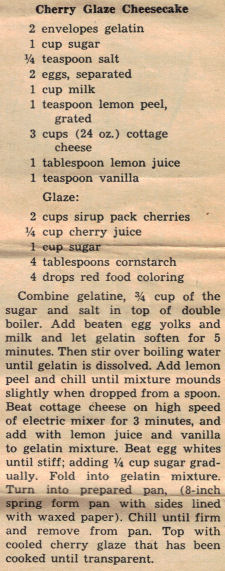 This is one of three recipes included in the 1959 magazine article: Tips For Canning & Freezing Berries. Recipe is typed below.
This is one of three recipes included in the 1959 magazine article: Tips For Canning & Freezing Berries. Recipe is typed below.
Cherry Glaze Cheesecake
2 envelopes gelatin
1 cup sugar
1/4 teaspoon salt
2 eggs, separated
1 cup milk
1 teaspoon lemon peel, grated
3 cups (24 oz.) cottage cheese
1 tablespoon lemon juice
1 teaspoon vanilla
Glaze:
2 cups sirup pack cherries
1/4 cup cherry juice
1 cup sugar
4 tablespoons cornstarch
4 drops red food coloring
Combine gelatine, 3/4 cup of the sugar and salt in top of double boiler. Add beaten egg yolks and milk and let gelatin soften for 5 minutes. Then stir over boiling water until gelatin is dissolved. Add lemon peel and chill until mixture mounds slightly when dropped from a spoon. Beat cottage cheese on high speed of electric mixer for 3 minutes, and add with lemon juice and vanilla to gelatin mixture. Beat egg whites until stiff; adding 1/4 cup sugar gradually. Fold into gelatin mixture. Turn into prepared pan, (8-inch spring form pan with sides lined with waxed paper). Chill until firm and remove from pan. Top with cooled cherry glaze that has been cooked until transparent.
This is the second of three recipes included in the 1959 magazine article: Tips For Canning & Freezing Berries. Recipe is typed below.
Before using this recipe, it’s important to read this page, the “Safe Canning & Food Preservation” section.
Blueberry Marmalade
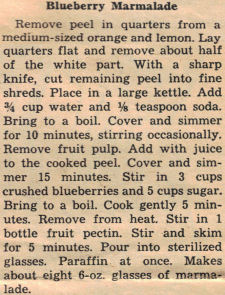 Remove peel in quarters from a medium-sized orange and lemon. Lay quarters flat and remove about half of the white part. With a sharp knife, cut remaining peel into fine shreds. Place in a large kettle. Add 3/4 cup water and 1/8 teaspoon soda. Bring to a boil. Cover and simmer for 10 minutes, stirring occasionally. Remove fruit pulp. Add with juice to the cooked peel. Cover and simmer 15 minutes. Stir in 3 cups crushed blueberries and 5 cups sugar. Bring to a boil. Cook gently 5 minutes. Remove from heat. Stir in 1 bottle fruit pectin. Stir and skim for 5 minutes.
Remove peel in quarters from a medium-sized orange and lemon. Lay quarters flat and remove about half of the white part. With a sharp knife, cut remaining peel into fine shreds. Place in a large kettle. Add 3/4 cup water and 1/8 teaspoon soda. Bring to a boil. Cover and simmer for 10 minutes, stirring occasionally. Remove fruit pulp. Add with juice to the cooked peel. Cover and simmer 15 minutes. Stir in 3 cups crushed blueberries and 5 cups sugar. Bring to a boil. Cook gently 5 minutes. Remove from heat. Stir in 1 bottle fruit pectin. Stir and skim for 5 minutes.
Pour into sterilized glasses. Paraffin at once.
Makes about eight 6-oz. glasses of marmalade.
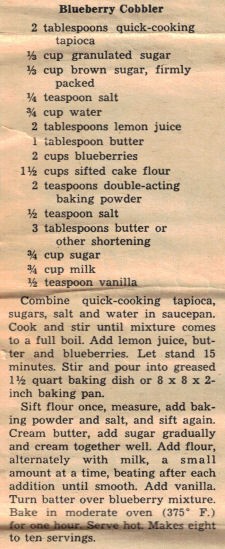 This is the first of three recipes included in the 1959 magazine article: Tips For Canning & Freezing Berries. Recipe is typed below.
This is the first of three recipes included in the 1959 magazine article: Tips For Canning & Freezing Berries. Recipe is typed below.
Blueberry Cobbler
2 tablespoons quick-cooking tapioca
1/3 cup granulated sugar
1/3 cup brown sugar, firmly packed
1/4 teaspoon salt
3/4 cup water
2 tablespoons lemon juice
1 tablespoon butter
2 cups blueberries
1 1/2 cups sifted cake flour
2 teaspoons double-acting baking powder
1/2 teaspoon salt
3 tablespoons butter or other shortening
3/4 cup sugar
3/4 cup milk
1/2 teaspoon vanilla
Combine quick-cooking tapioca, sugars, salt and water in saucepan. Cook and stir until mixture comes to a full boil. Add lemon juice, butter and blueberries. Let stand 15 minutes. Stir and pour into greased 1 1/2 quart baking dish or 8 x 8 x 2-inch baking pan.
Sift flour once, measure, add baking powder and salt, and sift again. Cream butter, add sugar gradually and cream together well. Add flour, alternately with milk, a small amount at a time, beating after each addition until smooth. Add vanilla. Turn batter over blueberry mixture. Bake in moderate oven (375° F.) for one hour. Serve hot. Makes eight to ten servings.
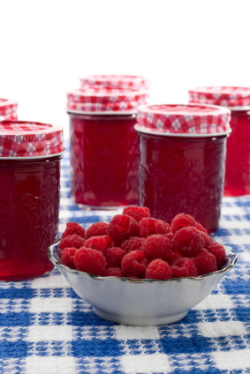 CHERRIES–Good quality cherries, sweet or tart, should be: Firm and shiny–to avoid over-ripeness and over-age. Plump and well-colored to insure ripeness. Free from blemishes or brown circular spots.
CHERRIES–Good quality cherries, sweet or tart, should be: Firm and shiny–to avoid over-ripeness and over-age. Plump and well-colored to insure ripeness. Free from blemishes or brown circular spots.
If stems are off, inspect for decay or broken skin. Those with broken skins spoil quickly.
To can sweet cherries–Wash, stem and pit the cherries, if desired. Wash jars and rinse in hot water. Pack the cherries in hot jars and cover with sirup to within one-half inch from the top of the jar. Prepare sirup by dissolving 1 1/2 parts sugar in two parts water.
Insert a table knife down sides of the jar to remove the air bubbles. Wipe the jar rim with a damp cloth and secure the lids according to the manufacturer’s directions. Place the filled jars in the boiling water bath. Allow three to four inch spaces between jars. Have the water level at least one inch above the tops of the jars. Process for 20 minutes. Start counting time when a rolling boil is reached. Remove from water and cool. Cherries for pies may be canned in water, but keep their color better when some sugar is used.
To freeze, wash, drain, pit or leave the cherries whole. Do not scald. Use a 40 to 60 per cent sirup or four to six parts berries to one of dry sugar.
RASPBERRIES or BLACKBERRIES–Choose berries that are clean, plump, free from caps, and free from green or other off-colors. Sandy berries are almost impossible to clean so you should avoid them. Stained boxes are a sign of over-ripe or crushed fruit. Each berry of any one variety has about the same number of seeds. So, your best buy for flesh and juice are the larger ones.
To can use a cold or raw pack for red raspberries and others which do not hold shape well. Make light or medium sirup. Wash and drain berries. Pour about one-half cup hot sirup into hot jar. Fill jar with berries. Shake jar to pack berries closely without crushing. Add enough sirup to cover berries. Process 20 minutes in boiling water bath.
Use a hot pack for blackberries and others that hold their shape. Wash, drain and measure firm, ripe berries. Put into kettle and add 1/4 to 1/3 cup sugar for each quart berries. Let stand two hours. Cook until sugar dissolves and berries are boiling hot. Pour, hot into hot jars. Add boiling water if there is not enough sirup to cover berries. Process 15 minutes in boiling water bath.
To freeze blackberries and black raspberries pick the berries over, rinse and drain. Pour 1/2 cup medium sirup into container. You do not need to add any acid. Add berries and enough sirup to cover them. Place a piece of crumpled cellophane or parchment paper on the berries. Cap with a tight lid.
For red raspberries rinse a few berries at a time in ice-cold water. Drain and freeze in medium sirup as explained above.
BLUEBERRIES–Choose berries that are plump, whole, dry and have an even, deep blue coloring. Decay is indicated by mold. A dull looking berry is probably over-ripe. A shriveled berry has been picked too long.
To can–These berries may be canned in sirup or water, but this method is better if berries are going to be used in muffins. Put two quarts clean berries in a square of cheesecloth. Hold cloth by the corners and dip into boiling water until spots appear on the cloth. Then dip into cold water. Pack into hot jars. (Add neither sugar nor liquid.) Process 20 minutes in boiling-water bath.
To freeze–scald the berries to prevent the skins from toughening during freezing. To do this place 1 1/2 quarts clean berries in a square of cheesecloth and hold in boiling water for one minute. Chill berries in cold water, drain, pack and freeze as explained for blackberries.
CURRANTS–Choose firm berries that are attached to the stems. Avoid those that are soft, discolored, or mushy. Most of these spicy little berries go into jams and jellies. But, they can be canned by the same method given for raspberries or blackberries.
If you are planning to use your berries fresh rather than canning or freezing them, plan to use them as soon as possible after buying them. They can be kept only about a week with proper storage in the refrigerator. A temperature of 30° to 32° F. and a relative humidity of 85 to 90 per cent is best. Wash just before using. Added moisture before storage will hasten mold and other forms of spoilage.
Source: This is a magazine article from 1959, you can see a scan of most of the article here–it’s been folded a few times and the article is also too large for my scanner but you can see most of it.
This recipe comes from a large lot of old recipe clippings for pickles, jams, jellies, relishes and more. Date is unknown but the collection suggests dates ranged from 1940s through the 1960s.
Before using this recipe, it’s important to read this page, the “Safe Canning & Food Preservation” section.
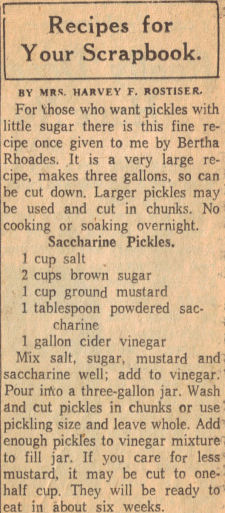 Recipes for Your Scrapbook.
Recipes for Your Scrapbook.
By Mrs. Harvey F. Rostiser.
For those who want pickles with little sugar there is this fine recipe once given to me by Bertha Rhoades. It is a very large recipe, makes three gallons, so can be cut down. Larger pickles may be used and cut in chunks. No cooking or soaking overnight.
Saccharine Pickles.
1 cup salt
2 cups brown sugar
1 cup ground mustard
1 tablespoon powdered saccharine
1 gallon cider vinegar
Mix salt, sugar, mustard and saccharine well; add to vinegar. Pour into a three-gallon jar. Wash and cut pickles in chunks or use pickling size and leave whole. Add enough pickles to vinegar mixture to fill jar. If you care for less mustard, it may be cut to one-half cup. They will be ready to eat in about six weeks.
This recipe clipping comes from a large lot of old recipe clippings for pickles, jams, jellies, relishes and more. Date is unknown but the recipes in this lot suggest 1940s through to the 1960s. Recipe is typed below.
Before using this recipe, it’s important to read this page, the “Safe Canning & Food Preservation” section.
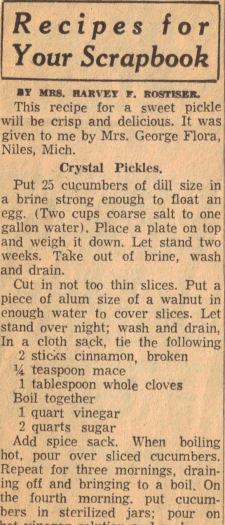 Recipes for Your Scrapbook
Recipes for Your Scrapbook
By Mrs. Harvey F. Rostiser.
This recipe for a sweet pickle will be crisp and delicious. It was given to me by Mrs. George Flora, Niles, Mich.
Crystal Pickles.
Put 25 cucumbers of dill size in a brine strong enough to float an egg. (Two cups coarse salt to one gallon water). Place a plate on top and weigh it down. Let stand two weeks. Take out of brine, wash and drain.
Cut in not too thin slices. Put a piece of alum size of a walnut in enough water to cover slices. Let stand over night; wash and drain. In a cloth sack, tie the following
2 sticks cinnamon, broken
1/4 teaspoon mace
1 tablespoon whole cloves
Boil together
1 quart vinegar
2 quarts sugar
Add spice sack. When boiling hot, pour over sliced cucumbers. Repeat for three mornings, draining off and bringing to a boil. On the fourth morning put cucumbers in sterilized jars; pour on hot vinegar solution and seal.
This recipe clipping comes from a large lot of old recipe clippings for pickles, jams, jellies, relishes and more. Date is unknown but the recipes in this lot suggest 1940s through to the 1960s. Recipe is typed below.
Before using this recipe, it’s important to read this page, the “Safe Canning & Food Preservation” section.
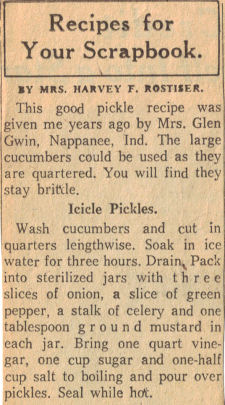 Recipes for Your Scrapbook
Recipes for Your Scrapbook
By Mrs. Harvey F. Rostiser.
This good pickle recipe was given me years ago by Mrs. Glen Gwin, Nappanee, Ind. The large cucumbers could be used as they are quartered. You will find they stay brittle.
Icicle Pickles.
Wash cucumbers and cut in quarters lengthwise. Soak in ice water for three hours. Drain. Pack into sterilized jars with three slices of onion, a slice of green pepper, a stalk of celery and one tablespoon ground mustard in each jar. Bring one quart vinegar, one cup sugar and one-half cup salt to boiling and pour over pickles. Seal while hot.

